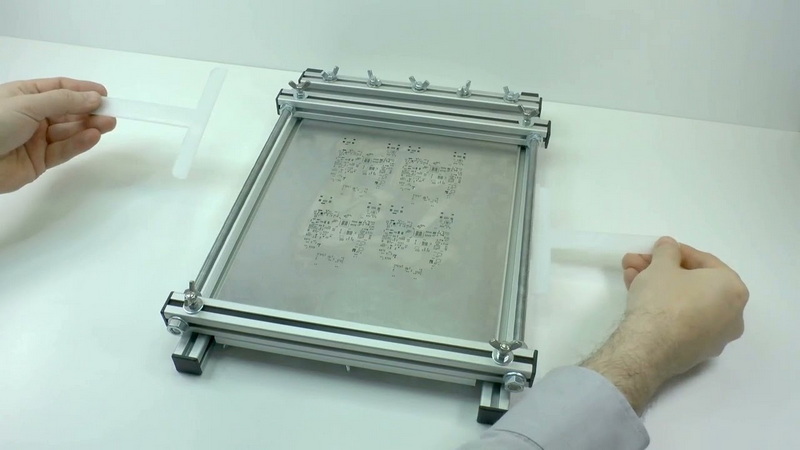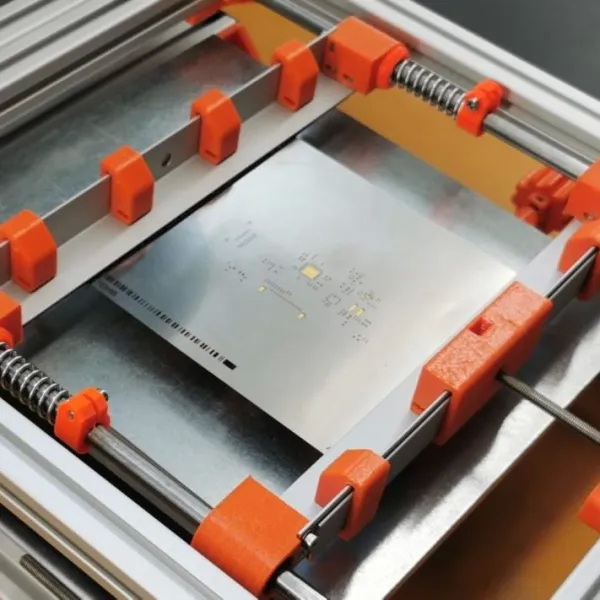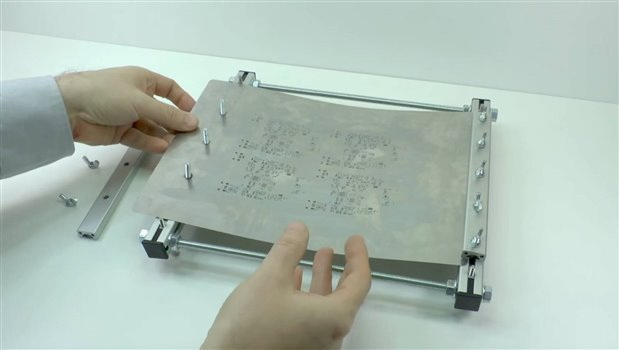Content Menu
● Understanding Stencil Printers for SMT
● Types of Stencil Printers for SMT
● Can Manual Stencil Printers Compete with Automatic Ones?
>> 1. Precision and Consistency
>> 2. Production Efficiency
>> 3. Cost Considerations
>> 4. Flexibility and Application Scope
● Advantages of Manual Stencil Printers for SMT
● Advantages of Automatic Stencil Printers for SMT
● Challenges and Limitations
● Practical Scenarios: When to Choose Which?
● Additional Considerations
● Conclusion
● FAQ
>> 1. What is a stencil printer for SMT?
>> 2. How does a manual stencil printer differ from an automatic one?
>> 3. Can manual stencil printers handle fine-pitch components?
>> 4. What are the cost differences between manual and automatic stencil printers?
>> 5. Is it possible to use both manual and automatic stencil printers in the same production line?
In the world of Surface Mount Technology (SMT), the stencil printer for SMT plays a critical role in the solder paste printing process, which directly affects the quality and reliability of electronic assemblies. Manufacturers often face the decision of choosing between manual, semi-automatic, and fully automatic stencil printers. This article explores whether a manual stencil printer can compete with an automatic one in SMT production, considering factors such as precision, efficiency, cost, and application scenarios.

Understanding Stencil Printers for SMT
A stencil printer for SMT is a machine used to apply solder paste onto a printed circuit board (PCB) through a stencil or screen. The stencil contains apertures that correspond to the pads on the PCB where components will be soldered. The solder paste is spread across the stencil, filling the apertures, and then the stencil is lifted to leave the paste on the PCB in precise locations.
Stencil printing is a fluid mechanics process that requires accuracy in positioning, pressure, speed, and alignment to ensure consistent solder paste deposits. The quality of this step is crucial for the subsequent pick-and-place and reflow soldering processes. Any variation in solder paste volume or placement can lead to defects such as solder bridging, insufficient solder joints, or tombstoning of components.
Types of Stencil Printers for SMT
- Manual Stencil Printers: Operated entirely by hand, where the operator manually places the PCB, applies solder paste, and uses a squeegee to spread the paste across the stencil. These printers are simple and cost-effective but rely heavily on operator skill.
- Semi-Automatic Stencil Printers: Combine manual loading and unloading of PCBs with automated control of printing parameters such as squeegee pressure, speed, and alignment assistance. They offer a balance between cost and automation.
- Fully Automatic Stencil Printers: Feature automated PCB handling, precise vision systems for alignment, automatic solder paste dispensing, and often include inspection functions like 2D/3D paste volume checking. These machines are designed for high-volume, high-precision SMT assembly lines.
Can Manual Stencil Printers Compete with Automatic Ones?
1. Precision and Consistency
Manual stencil printers rely heavily on the operator's skill and experience. The pressure, speed, and angle of the squeegee are controlled by hand, which can lead to variability in solder paste volume and placement. This variability can cause defects such as insufficient solder, bridging, or misalignment. The repeatability of the printing process is limited by human factors such as fatigue and inconsistency in technique.
In contrast, automatic stencil printers use precise mechanical and vision systems to control these parameters consistently, resulting in higher repeatability and fewer defects. They can handle fine-pitch components and complex PCB designs more reliably. Automated printers often incorporate closed-loop control systems that adjust printing parameters in real time to maintain optimal paste deposition.
However, for simple, low-volume, or prototype runs, manual stencil printers can still deliver acceptable precision if operated carefully, especially on PCBs with larger pads and less complex layouts. In such cases, the cost savings and flexibility of manual printers can outweigh the benefits of automation.
2. Production Efficiency
Automatic stencil printers excel in high-volume production environments due to their speed and ability to handle continuous PCB feeding without operator intervention. They reduce labor costs and operator fatigue, increasing throughput and yield. The cycle times of automatic printers are typically much shorter, allowing manufacturers to meet tight production deadlines.
Manual stencil printers are slower and labor-intensive, suitable mainly for small batches, repair work, or R&D labs where flexibility and low initial investment are priorities. The manual process requires careful attention and can be time-consuming, especially for complex or double-sided boards.
3. Cost Considerations
Manual stencil printers have a significantly lower upfront cost, making them attractive for startups, small manufacturers, or those with limited budgets. They require minimal maintenance and no complex training. The simplicity of manual printers also means fewer parts that can break or require replacement.
Automatic stencil printers involve substantial capital investment, ongoing maintenance, and operator training costs. However, their higher throughput and reduced defect rates can justify the expense in medium to large-scale production. Additionally, automatic printers often reduce the need for rework and scrap, which can translate into significant cost savings over time.
4. Flexibility and Application Scope
Manual stencil printers offer flexibility for double-sided assembly and small to medium PCB sizes without the need for mounting holes or complex fixtures. They are easy to set up and can be used in environments with space constraints. Because manual printers do not rely on automated feeders or conveyors, they can accommodate irregularly shaped boards or prototypes that would be difficult to process automatically.
Automatic stencil printers provide advanced features such as automatic stencil erection, vision alignment, and integration with Industry 4.0 systems, enabling them to adapt to a wide range of PCB sizes, component types, and production volumes. They can handle complex stencil designs and fine-pitch components with high precision, which is increasingly important as electronics become smaller and more densely packed.
Advantages of Manual Stencil Printers for SMT
- Low Cost: Affordable entry point for small-scale or prototype production.
- Simplicity: Easy to operate without complex programming or setup.
- Compact Size: Requires minimal space, suitable for labs or small workshops.
- Flexibility: Can handle double-sided printing and various PCB thicknesses with ease.
- Quick Setup: Manual positioning allows for rapid changeovers and minimal downtime.
- Operator Control: Skilled operators can make real-time adjustments to address specific issues.

Advantages of Automatic Stencil Printers for SMT
- High Precision: Automated control of squeegee pressure, speed, and alignment ensures consistent solder paste application.
- Increased Throughput: Automated PCB handling and printing speed improve production capacity.
- Reduced Defects: Vision systems and inspection functions minimize errors and rework.
- Advanced Features: Integration with IoT and Industry 4.0 enables real-time monitoring and predictive maintenance.
- Scalability: Suitable for mass production and complex PCB designs with fine-pitch components.
- Data Collection: Automatic printers can log printing parameters and inspection results for quality control and traceability.
Challenges and Limitations
- Manual Printers: Operator dependency can lead to inconsistent results; not ideal for complex or high-volume production. Fatigue and human error can affect quality, and manual printing is generally slower.
- Automatic Printers: High initial investment and maintenance costs; requires skilled operators and training. The complexity of the machines means downtime can be longer if technical issues arise.
Practical Scenarios: When to Choose Which?
| Scenario | Recommended Stencil Printer Type |
| Prototyping and R&D | Manual stencil printer |
| Small batch and low volume | Manual or semi-automatic stencil printer |
| Medium to high volume | Semi-automatic or fully automatic printer |
| Complex, fine-pitch PCBs | Fully automatic stencil printer |
| Budget constraints | Manual stencil printer |
| Need for high repeatability | Automatic stencil printer |
| Space constraints | Manual stencil printer |
| Double-sided assembly | Manual stencil printer (due to flexibility) |
Additional Considerations
Operator Training and Skill: The effectiveness of a manual stencil printer largely depends on the operator's expertise. Skilled technicians can achieve surprisingly good results with manual printing, but this requires training and experience. Automatic stencil printers reduce the dependency on operator skill, standardizing the process.
Maintenance and Downtime: Manual stencil printers have fewer mechanical parts and therefore generally require less maintenance. Automatic stencil printers, while more complex, often come with diagnostics and remote support, which can minimize downtime if managed properly.
Environmental Factors: In some environments, such as small labs or field repair stations, manual stencil printers are more practical due to their portability and simplicity. Automatic printers require stable power supplies, controlled environments, and space for conveyors and feeders.
Future Trends: As SMT technology advances, component sizes continue to shrink, and PCB designs become more complex. This trend favors automatic stencil printers with precise control and inspection capabilities. However, manual stencil printers will continue to have a place in prototyping, education, and low-volume manufacturing.
Conclusion
A manual stencil printer for SMT can compete with an automatic one in specific contexts, particularly in low-volume, simple PCB assembly, prototyping, or environments with budget and space limitations. It offers flexibility, ease of use, and cost-effectiveness for small-scale operations.
However, in medium to high-volume production, or when dealing with complex, fine-pitch components, automatic stencil printers provide superior precision, consistency, and efficiency. Their advanced features, automation, and integration capabilities make them indispensable for modern SMT manufacturing lines aiming for high yield and minimal defects.
Ultimately, the choice depends on production requirements, budget, and desired quality levels. For many manufacturers, a combination of manual or semi-automatic printers for prototyping and automatic printers for mass production offers the best balance. Understanding the strengths and limitations of each type of stencil printer for SMT is essential to optimize the solder paste printing process and ensure the success of the entire SMT assembly.

FAQ
1. What is a stencil printer for SMT?
A stencil printer for SMT is a machine used to apply solder paste onto PCBs through a stencil, ensuring precise placement of solder paste on component pads before assembly.
2. How does a manual stencil printer differ from an automatic one?
Manual stencil printers require hand operation for applying solder paste and positioning PCBs, while automatic printers use automated PCB handling, vision alignment, and controlled printing parameters for higher precision and speed.
3. Can manual stencil printers handle fine-pitch components?
Manual stencil printers are generally less effective for fine-pitch components due to variability in paste application. Automatic printers are better suited for such precise requirements.
4. What are the cost differences between manual and automatic stencil printers?
Manual stencil printers have a lower upfront cost and maintenance expense, making them suitable for small-scale use. Automatic printers require significant investment but offer higher throughput and quality.
5. Is it possible to use both manual and automatic stencil printers in the same production line?
Yes, many manufacturers use manual or semi-automatic printers for prototyping and low-volume runs, while relying on automatic stencil printers for mass production to optimize cost and efficiency.




















